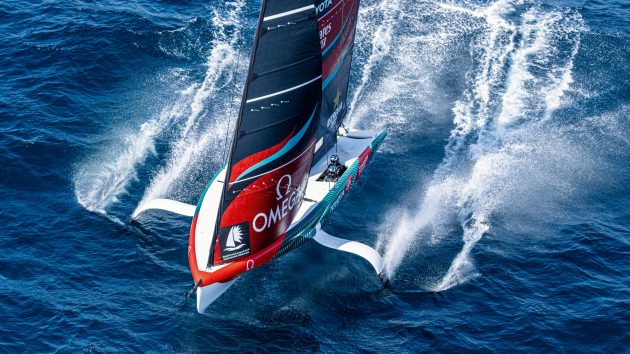Slam dunk and lee-bow tacks: the America’s Cup event in Jeddah showed that winning on foils is no longer about banging a corner at pace
Another AC40 streaked past the sea wall at 40 knots and I felt rather foolish. I’ve been following the development of these one design flying machines and reporting on their progress step by step since the concept was first announced.
I’ve sat in the cockpit of the Kiwi boat and been talked through the controls and shown how to get airborne, tack and gybe. I’ve even had a go in a couple of very realistic simulators to put theory into practice. And I’ve spent hours looking at the boats on the dock and even longer looking at footage of them in great detail when they’ve been training and racing.
Yet it’s not until you see one fly past for real that the penny really drops. These are insanely fast boats that are redefining what high performance really means.
In Jeddah, Saudi Arabia, at the second of the America’s Cup preliminary regattas, the bottom of the race course was very close to a shoreline that is several hundred metres deep. So the fly-by each team performed before the start was spectacular and provided an opportunity for those on shore to get close to these beasts at speed. You could almost feel the vacuum they left behind and you could certainly hear the distinctive, spine tingling whistle of the foils.

Luna Rossa Prada Pirelli and French challenger Orient Express. Photo: Ian Roman/America’s Cup
But this event was about far more than showing off impressive top speeds. It was an event that I and many others believe will go down as a benchmark in the development of racing on foils. It also delivered a serious shock to some of the big teams.
The three-day America’s Cup Preliminary Regatta kicked off with a steady 6-7 knot breeze, just enough to see the AC40s up on their foils. The action was close right from the start making it clear that teams had upped their game since the first event in Vilanova.
But it was the three races on day two that really grabbed attention. With around 15-16 knots of breeze the fleet was flying upwind at 32 knots. There’s nothing new in this, we’ve seen it before with the AC75s last time around and the SailGP flying cats. But what made this different is that everyone seemed to have figured out how to tack efficiently.
Typically, high performance cats, skiffs and foiling designs risk losing loads of distance through a tack – which in turn means they tend to minimise them and head out to the boundaries. This makes for little boat-on-boat engagement as teams bang the corners time after time.
Article continues below…
When is the next America’s Cup? 2024 dates released
The next America’s Cup will take place in Barcelona with six teams set to compete for sailing’s ultimate price from…
America’s Cup boats: 8 facts about the AC75 and why they’re unique
The AC75 is the class of boat that takes part in the America’s Cup and are arguably the most radical…
Not in Jeddah. All the teams have learned how to minimise the losses in a tack to such a degree that they were tacking up the middle of the course, throwing lee bow tacks underneath their opponents, or slam-dunking them from to weather.
The result was close action such as we haven’t seen since the days of the IACC lead mine monohulls. The pace at which the teams were locking horns was unbelievable. From closing speeds of 60 knots, to leeward squeezes and mark roundings that looked like the first turn in an F1 grand prix, the speed of the racing was incredible.
For the second and third races of the day, with a sea state building all the time, things got even more compelling. In these conditions it was easy to see just how on the edge these boats are, hurtling downwind at 43 knots as crews struggle to keep the drag down by flying the boat high, while also keeping enough foil in the water to avoid tripping up. Not everyone succeeded.

Ruggero Tito and Marco Gradoni impressed for Luna Rossa Prada Pirelli. Photo: Carlo Borlenghi
Talking to the crews afterwards they were clear this was new territory for all.
“We do these kinds of speeds all the time in training and have been doing this for quite some time,” Emirates Team New Zealand helmsman Nathan Outteridge told me. “But doing it in a closely packed fleet of six boats that are all travelling at the same pace is a big step up. It’s taking us onto another level. The decision making has to be quick and precise.”
It’s easy to think the AC40 racing in Jeddah demonstrates how far this kind of sailing has strayed from the ‘real world’ for younger up-and-coming sailors. But the Italian performance countered this argument with 19-year-old Marco Gradoni one of two young helms who delivered a giant slaying performance to put Luna Rossa Prada Pirelli second overall.
High speed, close tactical racing and a new generation of impressive talent: if this is where the bar is now set, the Youth America’s Cup could be quite some event.
 If you enjoyed this….
If you enjoyed this….
Yachting World is the world’s leading magazine for bluewater cruisers and offshore sailors. Every month we have inspirational adventures and practical features to help you realise your sailing dreams.Build your knowledge with a subscription delivered to your door. See our latest offers and save at least 30% off the cover price.






